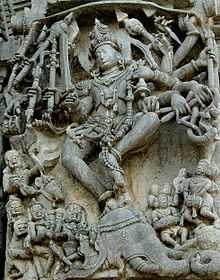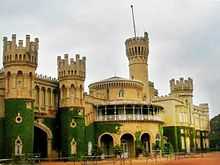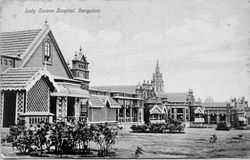History of Bangalore
Bangalore (/ˈbæŋɡəlɔr/; Kannada: ಬೆಂಗಳೂರು, IPA: [beŋɡaɭuːru]) is the capital and IT city of the Indian state of Karnataka.
Bangalore, or Bengaluru, as it is known today, was founded by Kempe Gowda, who built a mud fort at the site in 1537. It has developed over the years into an industrial and technological hub in India. A website of the heritage of the city, including the built, natural and cultural history of the city and the region is at www.bangaloreheritage.in.
Gangas, Cholas and Hoysalas
The Gangas ruled Gangavadi from Kolar starting c. 350 and later shifted their capital to Talakadu.Their rule often extended over large parts of Tamil Nadu.[1] An article, published in The Hindu, states:[2]
- An inscription, dating back to 890 AD, shows Bengaluru is over 1,000 years old. But it stands neglected at the Parvathi Nageshwara Temple in Begur near the city ... written in hale Kannada (old Kannada) of the 9th Century, the epigraph refers to a Bengaluru war in 890 AD in which Buttanachetty, a servant of Nagatta, died.
Though this has been recorded by historian R. Narasimhachar in his "Epigraphia of Carnatica" (Vol. 10 supplementary), no efforts have been made to preserve it. The inscription stone found near Begur reveals, that the district was part of the Ganga kingdom ruled from Gangavadi until 1024 C.E and was known as 'Benga-val-oru', the City of Guards in old Kannada.
Edgar Thurston (Castes and Tribes of India Volume 5) states that the Kongu region was ruled by a series of twenty eight kings before being conquered by the Cholas of Tanjore, citing the earliest portion of the Kongu Chronicle - Kongu Desa Rajakkal (a manuscript in The Mackenzie Collection) which gives a series of short notices of the reigns of all the kings who ruled the country from the start of the Christian era till its conquest by the Cholas. These kings belonged to two distinct dynasties: the earlier line of the Solar race which had a succession of seven kings of the Ratti tribe, and the later line of the Ganga race, itself claimed to be a branch of the Solar race.

In the year 1120 AD, the Hoysala King, Veera Ballala ruled the Deccan plateau or the South of India. On a hunting trip in the forest he lost his way. After a long search he met an old lady in the forest who offered him shelter for the night and served him some boiled beans for dinner. To show his gratitude to this lady for having saved his life, the King constructed a town and named it as Benda Kalooru which means town of boiled beans. Later in 1537, a local chieftain, Kempe Gowda helped design this town and give it its modern shape.
In 1024 C.E, the Chola Empire captured the city. Today, little evidence can be seen of this period. A small village in south Bengaluru and one in Anantapur district bear the Chola name but the residents are of native stock. The later Gangas often fought alongside the Chalukyas, Rastrakutas and the Hoysalas. In 1117 C.E, the Hoysala king Veera Ballala II defeated the Cholas in the battle of Talakad which lead to the downfall of the Chola empire.
A popular anecdote recounts that the 11th-century Hoysala king Veera Ballala II, while on a hunting expedition, lost his way in the forest. Tired and hungry, he came across a poor old woman who served him boiled lady's finger. The grateful king named the place "benda kaal-ooru" (Kannada: ಬೆಂದ ಕಾಳು ಊರು) (literally, "town of boiled beans"), which was eventually colloquialised to "Bengalūru".[3] There are also theories that the name has a floral origin and is derived from the tree Benga or "Ven-kai", also known as the Indian Kino Tree (Pterocarpus marsupium).[4] The city as it is known today was named by Kempe Gowda I.
There is an inscription dated 1628 C.E in the Ranganatha Temple in Telugu. The English translation of which is "Be it well, When Rajadhi-Raja-Parameshwara Vira Pratapa Vira-Maha-Deva Maharaya seated in the Jewel throne was ruling the empire of the world: When of the Asannavakula, the Yelahanka Nadu Prabhu Kempanacharya-Gauni's grandson Kempe Gowda's son, Immadi Kempegaunayya was ruling a peaceful kingdom in righteousness with the decline of the Vijayanagar empire, the eclipse of the rule of Yelahanka Nadu Prabhus took place at the dawn of the 17th century."
Vijayanagara and Kempe Gowda
Kempe Gowda I (1510–1570), Modern Bengaluru was founded by a feudatory of the Vijayanagara Empire, who built a mud fort in 1537. Kempe Gowda also referred to the new town as his "gandu bhoomi" or "Land of Heroes".[5] Within Bangalore, the town was divided into petes (IPA: [pete]) or market. The town had two main streets: Chickkapete Street ran east-west and Doddapete Street ran north-south. Their intersection formed Doddapete square — the heart of then Bangalore. Kempe Gowda's successor, Kempe Gowda II, built temples, tanks including Kempapura and Karanjikere tanks and four watching towers that marked Bengaluru's boundary.[6]
The four watchtowers built at the time in Bengaluru are still seen today.
- in Lal Bagh
- near Kempambudhi tank
- near Ulsoor Lake
- near Mekhri Circle
Sultanate of Bijapur
It was captured by the Maratha chief Shahaji Bhonsle, father of Shivaji, then working for the Adil Shahi sultans of Bijapur in 1638. During the siege of Bengaluru, Shivaji's elder brother Sambhaji was killed by Shahaji's rivals, led by the Ghorpade of Mudhol, for which Shivaji was to later exact revenge.
Mughal Influence
After conquering the Sultanate of Bijapur, the Mughals under the commandership of Khasim Khan, then arrived in Bengaluru, which was then ruled by Shivaji's brother Vyankoji Bhonsale as a jagir (fief) of Bijapur in 1686; Vyankoji retreated further south.
The Mughals in turn leased Bengaluru to the subsidiary Kingdom of Mysore's ruler Chikkadevaraja Wodeyar in 1689. In 1759, the Wodeyar's Commander-in-Chief Haider Ali made himself the de facto ruler of the Mysore Kingdom, including Bengaluru, but maintained the Wodeyars as a figurehead.
Hyder Ali and Tipu Sultan
When Hyder Ali died, his son Tipu Sultan deposed the weak Wodeyar, proclaimed himself Sultan. Under Tipu Sultan and Hyder Ali the state progressed economically and trade flourished with many foreign nations through the ports of Mangalore. Several attempts by the British to capture Bengaluru were repulsed by the Mysorean Army, most notably in 1768 when Hyder Ali forced Colonel Nicholson of the British Army to lift his siege of Bengaluru. The French under Napoleon had promised to drive the British from India. Tipu successfully stalled the British in the first, second and third Anglo-Mysore Wars.
Bangalore fort was captured by the British armies under Lord Cornwallis on 21 March 1791 during the Third Anglo-Mysore War and formed a centre for British resistance against Tipu Sultan,[7] being incorporated into the British Indian Empire after Tipu Sultan was defeated and killed in the Fourth Anglo-Mysore War (1799). A prominent role was played by the Madras Sappers in the capture of the Fort and subsequent development of the cantonment and the city. Bangalore is the permanent home of this Indian Army regiment since the mid-nineteenth century.
Wodeyars and British East India
Upon the passing of Tipu Sultan, the Wodeyars returned to the throne of Mysore, and therefore Bengaluru, although only as figureheads. Bengaluru remained part of British East India until Indian independence in August, 1947.
The 'Residency' of Mysore State was first established at Mysore in 1799 and later shifted to Bengaluru in the year 1804. It was abolished in the year 1843 only to be revived in 1881 at Bengaluru and finally to be closed down in 1947 with the departure of the British. (http://rajbhavan.kar.nic.in/history/fromresi-rajbhavan.htm)
The British troops which were first stationed at Srirangapatna after the fall of Tipu Sultan in 1799 were later shifted to the Civil and Military Station of Bengaluru in 1809.
The salubrious climate of Bengaluru attracted the ruling class and led to the establishment of the famous Military Cantonment, a city-state close to the old town of Bengaluru. The area became not only a military base for the British but also a settlement for a large number of Europeans, Anglo-Indians and missionaries.

In Cantonment, the names of many of its streets are derived from military nomenclature — Artillery Road, Brigade Road, Infantry Road and Cavalry Road. The South Parade (now known as Mahatma Gandhi Road, was to the south of the Parade Ground. The Plaza theatre was constructed in the year 1936 on the South Parade and was used by the soldiers for viewing Hollywood movies. The British representative maintained a residence within the cantonment area and his quarters was called the Residency and hence the name Residency Road. Around 1883, three developments were added to the cantonment — Richmond Town, Benson Town and Cleveland Town.
The Cantonment has retained it distinct atmosphere through the years with large populations of Anglo-Indians and Tamils from the British era.

Water shortages
The lack of water supplies within the city of Bengaluru was first tacked in 1873 by building a chain of tanks called Miller's Tanks in the Cantonment area. Prior to this water was pumped from the Halsoor, Shoolay and Pudupacherry tanks which were insufficient for the Civil and Military Station. The city area drew water from a Karanjee system from Dharmambudhi and Sampangi tanks. The Great Famine of 1875-77 and the failure of the monsoons led to drying of all these water bodies. During this time water carriers Bihistis supplied water. In 1882 the Sankey Reservoir was constructed at the cost of 5.75 Lakhs by Richard Hieram Sankey and collected rain water from an area of 2.5 square miles (6.5 km2). The water was said to be unsavoury and impure. On June 23, 1896 water was pumped from the Chamarajendra Reservoir (Hessarghatta) which dammed the waters of the Arkavathi. This tank went dry for one year in 1925. It was built at the cost of Rs 20,78,641. On 15 March 1933, the Thippagondanahalli Reservoir was put into service. On 21 May 1961, the Integrated Water Supply Scheme was inaugurated. This system collected water from the Cauvery river near Halgur and pumped up at Thorekadanahalli, Voddaradoddi, Gantakanadoddi and Tatguni and stored in reservoirs at Mount Joy, Byrasandra and High Grounds.[8]
Plague-Crisis of 1898
Bengaluru was hit by a plague epidemic in 1898. The epidemic took a huge toll and many temples were built during this time, dedicated to the goddess Mariamma. The crisis caused by this epidemic catalyzed the improvement and sanitation of Bengaluru and, in turn, improvements in sanitation and health facilities helped to modernize Bengaluru.
Telephone lines were laid to help coordinate anti-plague operations. Regulations for building new houses with proper sanitation facilities came into effect. A health officer was appointed in 1898, the city was divided into four wards for better coordination and the Victoria Hospital was inaugurated in 1900 by Lord Curzon, the then Viceroy and Governor-General of British India.
1900s

In 1906, Bengaluru became the first city in Asia to have electricity, supplied by the hydroelectric plant situated in Shivanasamudra.
Basavanagudi (named either after the Basavanna Temple or the Bull Temple in the village of Sunkenahalli) and Malleshwaram (named after the Kadu Malleshwara Temple in the old Mallapura village) were created during this time. Kalasipalyam (near the old fort) and Gandhinagar were created between 1921-1931.
Bangalore's reputation as the Garden City of India began in 1927 with the Silver Jubilee celebrations of the rule of Krishnaraja Wodeyar IV. Several projects such as the construction of parks, public buildings and hospitals were instituted to improve the city. [9] Bangalore therefore served traditionally as a retreat for people from the surrounding South Indian regions. Even today, the city administration manages to maintain several parks. Cubbon Park and Lal Bagh are two such examples.
Indian Independence (1947)
After Indian independence in August 1947, Bangalore remained in the Mysore State of which the Maharaja of Mysore was the Rajapramukh.[9]

Bangalore continued to be the capital of the unified and linguistically homogeneous Kannada-speaking new Mysore state that was created in 1956, and renamed to Karnataka in 1973.
Kumara Park came into existence in 1947 and Jayanagar in 1948. In the 1960s and 1970s an elite neighborhood was developed in the former gardens of the Bengaluru Palace, which was known as "Palace Orchards" now called Sadhashivnagar. The area is now home to many of the wealthy members of Bengaluru society, celebrities and politicians.
Public sector employment and education provided opportunities for Kannadigas from the rest of the state to migrate to the city. Bangalore explargest city in India, with a population of 1,207,000. [10] In the decades that followed, Bangalore's manufacturing base continued to expand with the establishment of private companies such as MICO (Motor Industries Company), which set up its manufacturing plant in the city. Industrialization created further growth that extended from the Peenya Industrial Area in the west to Indiranagar and Whitefield in the east; from Yelahanka Town in the north, to J.P. Nagar in the south.
1991 Economic Reforms
Bangalore experienced a growth in its real estate market in the 1980s and 1990s, spurred by capital investors from other parts of the country who converted Bangalore's large plots and colonial bungalows into multi-storied apartments. [11] In 1985, Texas Instruments became the first multinational corporation to set up base in Bangalore. Other information technology companies followed suit and by the end of the 20th century, Bangalore had firmly established itself as the Silicon Valley of India.
With an estimated population of 8.5 million in 2011, [12] Bangalore is now the fourth most populous city in India and the 28th most populous city in the world. [13] Bangalore was the fastest-growing Indian metropolis after New Delhi between 1991–2001.
In 2005, the Government of Karnataka announced it had accepted a proposal to rename Bangalore to Bengaluru. [14] In 2006, the Bruhat Bengaluru Mahanagara Palike (BBMP), the third level of government, passed a resolution to implement the proposed name change. [15] However, this process has been currently stalled due to delays in getting clearances from the Union Home Ministry.[16]
| Historical population | ||
|---|---|---|
| Year | Pop. | ±% |
| 1871 | 142,513 | — |
| 1881 | 155,857 | +9.4% |
| 1891 | 180,366 | +15.7% |
| 1901 | 159,030 | −11.8% |
| 1911 | 189,485 | +19.2% |
| 1921 | 237,496 | +25.3% |
| 1931 | 306,470 | +29.0% |
| 1941 | 406,760 | +32.7% |
| 1951 | 778,977 | +91.5% |
| 1961 | 1,199,931 | +54.0% |
| 1971 | 1,653,779 | +37.8% |
| 1981 | 2,913,537 | +76.2% |
| 1991 | 3,628,165 | +24.5% |
See also
- History of India
- Bengaluru
- Bengaluru Pete
- Mysore State
Notes
- ↑ "History of Bangalore".
- ↑ "Inscription reveals Bengaluru is over 1,000 years old". The Hindu. 2006. The Hindu Group. 20 Aug. 2004
- ↑ http://www.deccanherald.com/deccanherald/Oct302006/index20581420061029.asp
- ↑ "History of Bangalore". Bangalore Guide 2006. Bangalore Guide
- ↑ "About Bangalore - History". Department of IT and Biotechnology. 2006. Government of Karnataka.
- ↑ Vagale, Uday Kumar. "Public Space in Bengaluru: Present and Future Projections". Digital Libraries and Archives. 2006. Virginia Tech. 27 Apr. 2004.
- ↑ Sandes, Lt Col E.W.C. (1933). The Military Engineer in India, Vol I. Chatham: The Institution of Royal Engineers. pp. 163–165.
- ↑ Hassan (1970):183-194
- ↑ 9.0 9.1 Srinivasaraju, Sugata (10 April 2006). "ElectriCity". Outlook India. Retrieved 15 November 2011.
- ↑ Digital Libraries and Archives
- ↑ Benjamin, Solomon. "Governance, economic settings and poverty in Bangalore" PDF (149 KB).Environment&Urbanization Vol 12 No 1 2006. United Nations Public Administration. 1 April 2000.
- ↑ "Urban Agglomerations/Cities having population 1 lakh and above" (PDF). Censusindia. The Registrar General & Census Commissioner, India. Retrieved 17 October 2011.
- ↑ "World: largest cities and towns and statistics of their population". World-Gazetter.com. Archived from the original on 17 Dec 2012. Retrieved 17 October 2007.
- ↑ "Bangalore to be renamed Bengaluru". Times of India (India). 11 December 2005. Retrieved 19 April 2009.
- ↑ "It will be `Bengaluru', resolves BMP". The Hindu (Chennai, India). 28 September 2006. Retrieved 16 May 2007.
- ↑ "Centre mum on ‘Bengaluru’". The Hindu (Chennai, India). 18 December 2007. Retrieved 10 April 2008.
References
- Fazlul Hasan. 1970. Bengaluru Through the Centuries. Historical Publications.
